How to Keep and Look After Your Anemometer to Make Sure Long Life
How to Keep and Look After Your Anemometer to Make Sure Long Life
Blog Article
All You Required to Learn About Anemometers: Exactly How They Work, Why They Matter, and Where to Make use of Them
Anemometers, however commonly overlooked in the world of clinical tools, play an important role in various areas, supplying beneficial insights right into wind rate and airflow patterns. Recognizing the auto mechanics behind these devices is crucial for anyone seeking to harness the power of this data. From meteorologists tracking weather condition patterns to engineers designing frameworks with wind lots in mind, the applications of anemometers are diverse and significant. As we dive right into the ins and outs of anemometer innovation, we will uncover the inner workings of these tools, their relevance, and the crucial considerations when selecting the appropriate anemometer for particular applications.

Anemometer Essentials
A necessary instrument made use of to determine wind rate and direction, the anemometer plays an important function in weather forecasting and numerous industries. An anemometer typically is composed of 3 or 4 cups that turn in the wind, a vane that aims into the wind, and sensing units to track the movements or rotations.
There are various kinds of anemometers offered, including cup anemometers, vane anemometers, hot-wire anemometers, and sonic anemometers, each with its unique functions and applications. Mug anemometers are frequently used for fundamental wind speed measurements, while vane anemometers are liked for directional measurements.
Principles of Anemometer Operation
Structure on the fundamental understanding of anemometer fundamentals, the concepts of anemometer procedure clarify the auto mechanics behind wind rate and direction dimensions. Anemometers operate the concept of airflow impacting a sensing unit, creating it to rotate. Cup anemometers, for example, have three or even more cups that catch the wind, creating them to rotate quicker as the wind speed boosts. The rotation speed is after that exchanged a wind speed measurement. Vane anemometers, on the various other hand, use a tail or a probe that straightens itself with the wind direction, giving a dimension of wind direction based on the alignment of the sensing unit. Hot-wire anemometers rely upon a heated cable that cools off as wind passes over it, with the rate of cooling identifying the wind rate. Ultrasonic anemometers step wind speed and direction by evaluating the moment it considers ultrasonic signals to take a trip in between transducers. Understanding these principles is crucial for trustworthy and accurate wind dimensions in numerous applications.
Importance of Anemometers
The relevance of anemometers in meteorology and various markets can not be overstated. Anemometers play an important function in gauging wind rate and instructions, supplying crucial data for weather condition forecasting, environment researches, ecological surveillance, and aeronautics operations. Meteorologists depend on anemometers to gather exact wind data, aiding them comprehend climate patterns, forecast storms, and problem prompt cautions to the public. In industries such as building, agriculture, sustainable power, and maritime procedures, anemometers are utilized to optimize procedures, guarantee safety and security, and increase performance. For example, wind ranch operators use anemometers to analyze wind problems and take full advantage of electrical power production from wind generators. In the maritime field, anemometers help ship navigation by providing real-time wind info to captains, helping them make educated decisions to guarantee risk-free trips. Overall, anemometers are important tools that add significantly to safety, efficiency, and notified decision-making in meteorology and a large range of markets.
Applications Throughout Various Industries
Applications of anemometers cover visit across varied sectors, showcasing their convenience and utility beyond meteorology. In the renewable resource sector, anemometers play an essential duty in analyzing wind conditions for wind farm positionings, making sure optimal energy manufacturing. Industries like building and mining make use of anemometers to monitor wind speeds, crucial for safety and security methods, especially when operating at elevations or in open-pit mines where strong winds can posture risks. Anemometers are likewise indispensable in the aeronautics market, helping pilots in understanding airspeed and wind instructions for secure liftoffs and landings. The maritime market take advantage of anemometers for ship navigation, aiding sailors expect weather condition adjustments and readjust courses accordingly. In farming, anemometers aid farmers in taking care of crop spraying by supplying real-time information on wind speed to avoid drift. Anemometers locate applications in Cooling and heating systems to enhance airflow and improve power effectiveness in buildings. The varied use instances of anemometers highlight their relevance throughout various markets, highlighting their crucial role in improving operational safety and effectiveness (anemometer).

Selecting the Right Anemometer for Your Requirements
For general you can try this out purposes, a mug anemometer is ideal for determining wind speed, while a vane anemometer provides wind direction data. Hot-wire anemometers are ideal for reduced airspeed dimensions, and ultrasonic anemometers supply high accuracy and resilience.

Conclusion
In verdict, anemometers play an essential role in measuring wind rate and instructions across different markets. It is crucial to consider the importance of anemometers in order to make informed choices when selecting the most ideal device for measuring wind problems.
There are numerous kinds of anemometers readily available, including mug anemometers, vane anemometers, hot-wire anemometers, and sonic anemometers, each with its special functions and applications. Cup anemometers are typically made use of for standard wind rate dimensions, while vane anemometers are favored for directional measurements. Hot-wire anemometers are ideal for low airspeeds, and sonic anemometers are suitable official site for high-precision measurements in research and industrial settings.Structure on the fundamental understanding of anemometer fundamentals, the principles of anemometer procedure illuminate the technicians behind wind speed and direction measurements. For general functions, a cup anemometer is suitable for determining wind speed, while a vane anemometer supplies wind direction information.
Report this page